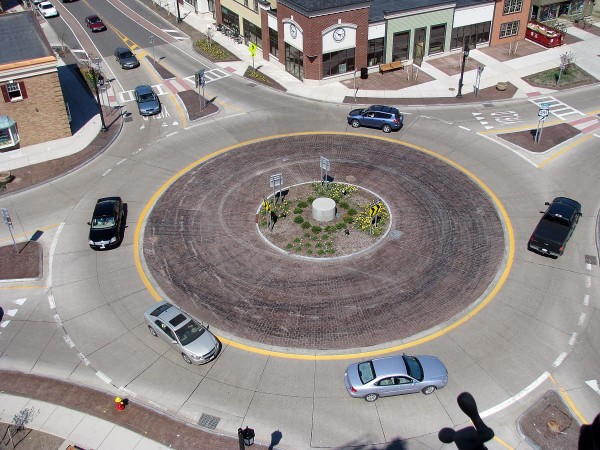Driving around Western New York, going to various clients, I’ve come across more intersections that were once 4-way stops or had stop lights, that have been replaced by roundabouts. The first time I came across a roundabout was while driving for the first time in England. Not only was I driving on the opposite side of the road, sitting on the opposite side of the car and shifting with my left hand; here in front of me was a “roundabout”. Now I knew of them and was a passenger while navigating them, but here I was confronted by this different type of obstacle. I will admit, the first time I was within one it took me a couple of revolutions to get my bearings while dodging other vehicles, but I made it through unscathed.
Later I was re-telling this experience to a number of colleagues while I was at the England facility I was visiting. After much humiliation and chagrin, they took me to a spot overlooking a roundabout that was at the exit of their industrial development, where you could watch the traffic flow. It was there, after a period of time watching that I came to the realization that traffic did not stop, it continued; maybe at a slower pace to start; but everything was flowing smoothly without stopping.
Continuous flow and batch size reduction are two of the important concepts of lean. This roundabout eliminated the wastes of waiting and inventory.
Let’s think of the cars as work items that are being completed and passed along to the next operation and let’s compare the two situations, 4-way stops vs. roundabouts…
4-way intersection with stop signs or stop lights:
Cars at each street must come to a complete stop, look to see if it is clear and then proceed on their way (right turn, straight ahead or left turn). If there is oncoming or adjacent traffic, then the car waits until it is their turn before proceeding. If traffic is busy and there is confusion of one or two drivers as to whose turn it is and how to proceed, there can be a backup (inventory) and waiting.
It is even worse with stop lights. These require you to wait for a set amount of time, even if the intersection is clear. Who hasn’t gotten frustrated sitting at a light late at night when there is no cross traffic? At least right-on-red, after stopping, has helped this issue.
Roundabouts…
Due to their design, these circles force all cars to slow down when approaching, but encourage continuous movement, unless there is another already in the roundabout where you want to go. This design allows for continuous flow and minimizes back-up of cars (inventory). This continuous flow philosophy allows the car to get to its destination sooner, especially if there are a number of roundabouts on your route vs. forced stops (reduces lead time); allows more cars to go through the intersection in the same amount of time (increases throughput); decreases driver frustration; and eliminates speeding up to make the light putting others in jeopardy (defects & expediting).
Remember, lean is a philosophy of small continuous improvements, to eliminate wastes and issues, making life easier for those involved. These improvement initiatives are all around us, not only in manufacturing but in everyday situations that we find ourselves in.
Jim Johnson has more than 30 years of diverse manufacturing experience in engineering, project management, new product development and continuous improvement. Prior to joining Insyte, Jim held a variety of engineering positions at Greatbatch, Fisher-Price and General Motors. He is an active senior member of the Institute of Industrial Engineers. Jim is certified as a Professional Business Advisor through MEP University, is an ISO provisional lead auditor, and a trainer in lean manufacturing initiatives. He is on the Board of Advisors of RIT’s Industrial and Systems Engineering Department. Jim holds an MS in Industrial Engineering from the University at Buffalo and a BS in Industrial Engineering from RIT.


